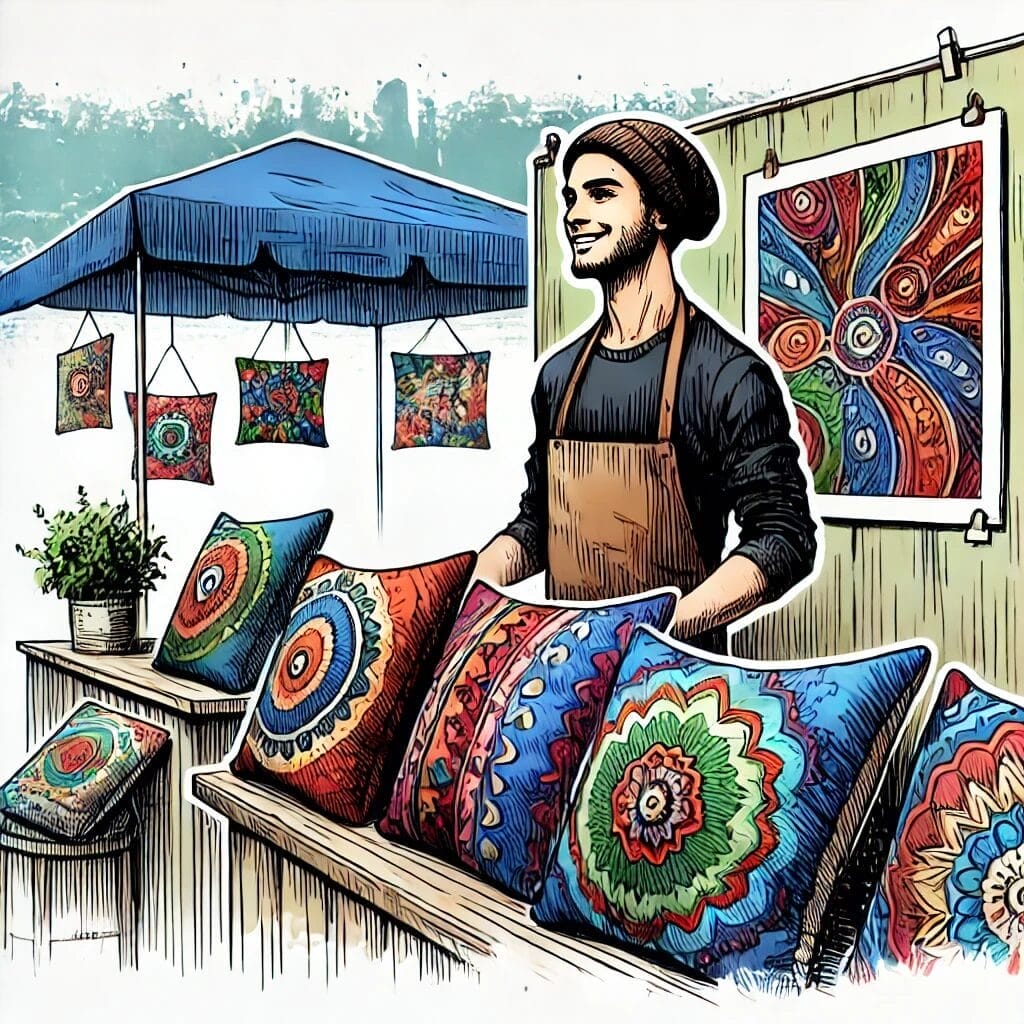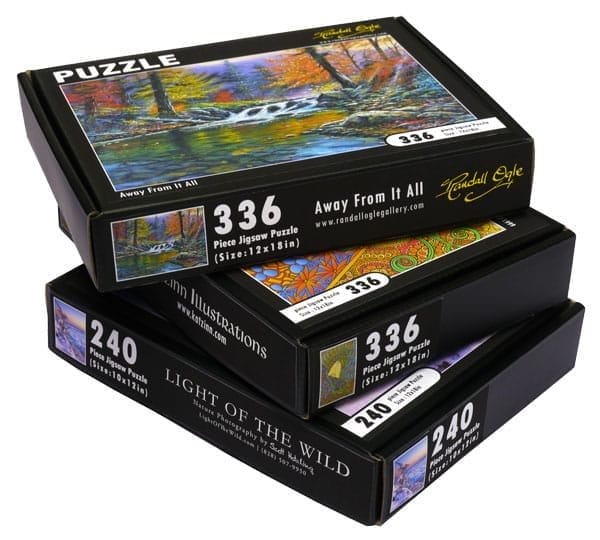Why Sell Your Art on Physical Products?
If you’re an artist, there are many ways to get your art out beyond galleries or digital sales. By putting your art on physical products, you can make it more accessible to a bigger audience and reach people who might not usually buy art.
People love functional art they can use in their daily lives, and this is an excellent way for you to make extra income while sharing your creativity in a new way. Imagine your art being worn as jewelry, decorating someone’s home, or even becoming a fun jigsaw puzzle—turning your creativity into something people can hold and enjoy is both exciting and rewarding.
We’ll walk through the steps needed to get started, where to sell your creations, and how to price your work so that your business can thrive. Ready to dive in? Let’s find the perfect fit for you!

READ MORE: 6 Online Business Ideas for Artists
1. Creating and Selling Handmade Art Products
Making handmade art products is one of the most rewarding ways to share your creativity—and get paid for it! Whether it’s jewelry, ceramics, or textiles, people absolutely love items that come straight from an artist’s hands. Handmade products have that special charm because they each have a story, a personal touch that makes them different from anything you’d find in a store.
| Potential Market | Eco-conscious buyers, craft lovers |
| Ease of Implementation | Moderate—requires practice |
| Skill Level Needed | Intermediate—crafting skills needed |
| Suggested Partners/Manufacturers | Local craft fairs, Etsy for supplies |
How to Get Started
First things first, pick a craft you love. It could be beading, pottery, or even weaving. Work on your skills and watch what’s trending in handmade markets. Research is key to understanding what handmade products sell well, so explore different platforms and trends. Check popular online marketplaces like Etsy, browse through Pinterest, and visit craft fairs to see what types of products are drawing attention.
People love eco-friendly materials, so think about using recycled metals for jewelry or organic fibers for textiles—good for the planet and your business! These research efforts will also help you identify gaps in the market, giving you ideas for products that could stand out. Take time to learn and practice, and don’t worry if your early pieces aren’t perfect; improvement comes with experience, and your journey adds value to your work.

Don’t be afraid to experiment with different styles and techniques to discover what makes your creations unique. Maybe you try weaving with unusual colors or adding a twist to traditional pottery shapes.
These experiments make your work stand out and help you figure out your style. Remember, the more you play around with your art, the better you understand what resonates with you and your audience.
Where to Sell
Etsy is an excellent place to start your online shop, but don’t stop there. Set up your own website and go local! Craft fairs are perfect for meeting people who appreciate handmade products and hearing their feedback. Maybe there’s even a local boutique that would love to carry your items. Plus, never underestimate the power of word-of-mouth—happy customers can help grow your business faster than you think!
Pricing Your Products
Pricing can be a bit tricky. It would be best to consider your time, materials cost, and skills. Don’t sell yourself short—people are willing to pay for handmade, quality items that tell a story. And as your business picks up, you might even consider hiring some help or outsourcing tasks. Set fair prices that reflect your hard work but also stay competitive. Remember, people are buying a piece of your passion!
2. Developing a Line of Art-Based Home Decor Products
Love interior design? Why not use your artistic skills to create beautiful home decor items? Wall art, decorative pillows, and vases are great ways to bring your art into someone’s home, transforming a room into something special. Home decor helps your art become part of someone’s daily life, making their home feel more like their own.
| Potential Market | Homeowners, interior design fans |
| Ease of Implementation | Moderate—requires design and production |
| Skill Level Needed | Intermediate—eye for design needed |
| Suggested Partners/Manufacturers | Local artisans, online print shops |
Finding Your Niche
Pick a niche that matches your skills and interests. Maybe it’s wall art with bold, abstract designs or cute, cozy throw pillows. Research is crucial to understanding what sells in the handmade market. Spend time looking at popular platforms like Etsy, Amazon Handmade, and Pinterest to see what types of home decor products are trending. Check out social media too—Instagram and TikTok are great for spotting new decor ideas that people love.

Check out current trends—eco-friendly and sustainable materials are super popular, so using reclaimed wood or natural fabrics can set you apart.
Seasonal or themed pieces are another great way to keep your collection fresh and exciting for customers. Understanding these trends will help you identify gaps in the market and design products that appeal to buyers, giving you an edge over the competition.
Designing for Versatility
Make sure your products can fit different styles—minimalist, boho, modern—so they’ll appeal to a wide range of buyers. Show how your items look in different types of rooms with great photos or short videos. People want to imagine your art in their space, so help them visualize how it would fit perfectly in their home.
3. Designing and Selling Art Prints, Posters, and Paper Products
Turning your art into prints, posters, and other paper products is an excellent way to make your work more affordable and accessible. Not everyone can buy an original painting, but a print? Absolutely! Prints are easy to produce in larger quantities, which means more people can enjoy your art without you having to make new pieces constantly.
| Potential Market | Art lovers, office decorators |
| Ease of Implementation | Easy—once designs are made |
| Skill Level Needed | Beginner—basic design skills |
| Suggested Partners/Manufacturers | Online print shops, local printers |
Doing Research to Identify Best-Selling Styles
Before creating your prints, it’s important to research what styles are currently popular and what people are buying. Look at best-sellers on platforms like Etsy, Amazon, and Society6. Notice if there are specific color palettes, subjects, or themes that are trending—like botanical prints, abstract art, or motivational quotes. Identifying what sells well will help you create prints that are more likely to be in demand.
It’s also helpful to understand seasonal demand. For example, floral and nature-themed prints often sell well in the spring, while cozy, festive designs are more popular around the holidays.
By creating seasonal collections, you can take advantage of these trends and ensure your products stay relevant throughout the year. Staying informed about what’s popular will give you an edge and help you decide what styles to focus on, ultimately improving your chances of success.
Marketing Your Prints
Get on social media! Instagram, Pinterest, and Facebook are your best friends when showing off your prints. Use hashtags, team up with other artists, and maybe even share some time-lapse videos of you creating the original pieces. Let people feel connected to your work—it makes them more likely to want it hanging on their wall.
Print Quality Matters
Good-quality paper and ink are a must. Test different printers until you find the one that does your art justice. Happy customers will return for more, so it’s worth investing in quality from the start. Offer different sizes or framing options too—people love having choices that fit their space and budget.
4. Launching Your Own Range of Jigsaw Puzzles

Have you ever thought about turning your art into a fun puzzle? Jigsaw puzzles are a perfect medium for visual art because your image becomes the main attraction. Each piece of the puzzle is like a fragment of your creativity, inviting people to connect with your art interactively.
Puzzles are entertaining and create a lasting bond between you and your audience as they witness your artwork come to life, piece by piece, in their own hands.
They offer an experience where your art isn’t just seen but truly engaged with, making it a rewarding and memorable journey for the puzzler.
READ MORE: Selling Your Artwork – Think “Inside the Box” to Sell More of Your Art
| Potential Market | Puzzle enthusiasts, gift buyers |
| Ease of Implementation | Easy |
| Skill Level Needed | Beginner—art and design only |
| Suggested Partners/Manufacturers | PuzzlesUnlimited.com |
How to Get Started
Creating puzzles with your artwork can be rewarding, but knowing where to begin is important. From choosing the right designs to finding reliable partners, here’s how to get started:
- Choose Puzzle-Friendly Artwork: Use bright colors, exciting patterns, and detail. The more intriguing your art, the more people will love putting it together! Make sure your designs grab attention with vibrant colors and tell a story that’s rewarding to complete.
- Research Popular Designs: Spend time researching what puzzle designs are trending. Amazon is a great place to see which styles, themes, and sizes are popular. Identify trends—are scenic views, abstract art, or animals in high demand? This research helps you choose artwork that will succeed.
- Find a Manufacturer: PuzzlesUnlimited.com is a good option for artists looking to create custom-printed puzzles. They make it easy for artists to launch their own range of puzzles by offering lower minimum order quantities, allowing you to create several different puzzles without committing to large quantities. Working with a manufacturer that understands the needs of artists ensures your puzzles come out looking vibrant and professional, from the pieces to the packaging.
Marketing Your Puzzle Line
Get creative with social media. Show off your puzzle pieces, run a giveaway, or host a challenge where people share pictures of their completed puzzles. And don’t forget about packaging—a well-designed box makes your puzzle an irresistible gift.
5. Creating and Selling Art Coloring Books
If you’re a sketch artist or illustrator, coloring books offer a fantastic opportunity. They let you take your existing work and transform it into something that people can engage with directly. Creating a series of themed coloring books allows you to develop a cohesive product line that showcases your unique style and builds a loyal following.
Whether it’s intricate patterns, whimsical characters, or scenic illustrations, coloring books allow you to expand your reach and create something that people will come back to again and again.
| Potential Market | Kids, adults who enjoy relaxation |
| Ease of Implementation | Easy—needs layout design |
| Skill Level Needed | Intermediate—illustration skills |
| Suggested Partners/Manufacturers | Local printers, Amazon KDP |
Coloring books aren’t just for kids anymore! Art coloring books are a big hit for adults seeking a creative and relaxing escape from their busy lives. These books offer a therapeutic experience, allowing people to unwind and focus on something enjoyable. Imagine your artwork becoming a part of someone’s self-care routine—it’s a wonderful way for your audience to interact with your art meaningfully.
The demand for adult coloring books has grown significantly in recent years, driven by people seeking stress relief and a fun way to relax.
Popular themes include mandalas, nature, animals, and abstract patterns, but there’s also a market for more unique, artistic styles that stand out.
By offering a coloring book that features your unique designs, you can tap into this growing market and provide something that’s both creative and calming.
Adult coloring books have a wide appeal, from those who enjoy art as a hobby to individuals who want to take a break from screens and indulge in a mindful activity.
How to Get Started

Pick your favorite drawings and turn them into coloring pages. Simplify the designs if needed so they’re fun to color without being too complicated. Remember, the goal is to make it enjoyable for all skill levels, so striking a balance between detail and simplicity is key.
Once you have enough pages, use a tool like Adobe Illustrator or Canva to assemble your book. These tools allow you to create a professional layout and ensure each page looks polished and consistent.
You might also consider adding some introductory pages with small descriptions of your illustrations or tips to get the best coloring results.
Consider partnering with print-on-demand services like Printful, Printify, or Lulu for your coloring books. These companies can handle printing and shipping, making it easy to get your coloring books into the hands of your customers without large upfront costs.
Selling Your Coloring Book
You can create physical copies to sell at markets or online, or make digital versions that people can download and print at home. Etsy is great for digital downloads, while Amazon’s Kindle Direct Publishing is perfect for physical books. Consider offering bundles or themed collections—people love to buy sets, especially for gifts!
6. Creating and Selling Art-Based Stationery and Gift Products
Want to take your art even further? Stationery and gift products are a fantastic way to bring your art into everyday moments—think about art-themed calendars, greeting cards, or even stationery sets. These items are practical, thoughtful, and perfect for gifts.
| Potential Market | Gift buyers, stationery fans |
| Ease of Implementation | Easy—customization is straightforward |
| Skill Level Needed | Beginner—basic graphic design |
| Suggested Partners/Manufacturers | Local print shops, online suppliers |
Product Ideas
- Art-Themed Calendars: Your best pieces, beautifully laid out for every month. A great way for people to enjoy your art all year long.
- Personalized Greeting Cards: Perfect for birthdays, holidays, or just because. Offering a personal touch can make all the difference.
- Creative Stationery Bundles: Notepads, pens, envelopes, stickers—your art can make everyday writing feel special.
Expanding Your Product Line
Consider items like tote bags, phone cases, or even apparel. People love items they can use every day, especially when they’re unique and artful. By offering practical products that are also beautiful, you’re giving customers something they can use and enjoy, all while showcasing your creativity.
READ MORE: Art Merchandise 101: Turning Artwork into Products
Next Steps: Turning Your Art into a Business
Many fun and exciting ways to start a physical product business with your art exist. Whether you’re making jewelry, puzzles, home decor, or coloring books, each idea taps into what people love—unique, personal, and meaningful items. Choose the concept that speaks to you, and start creating!
Experiment, explore, and don’t be afraid to try something new. Building a business takes dedication, but it hardly feels like work when you’re doing something you love. The world needs more art—especially art people can use, enjoy, and experience daily. So put yourself out there and make it happen!






